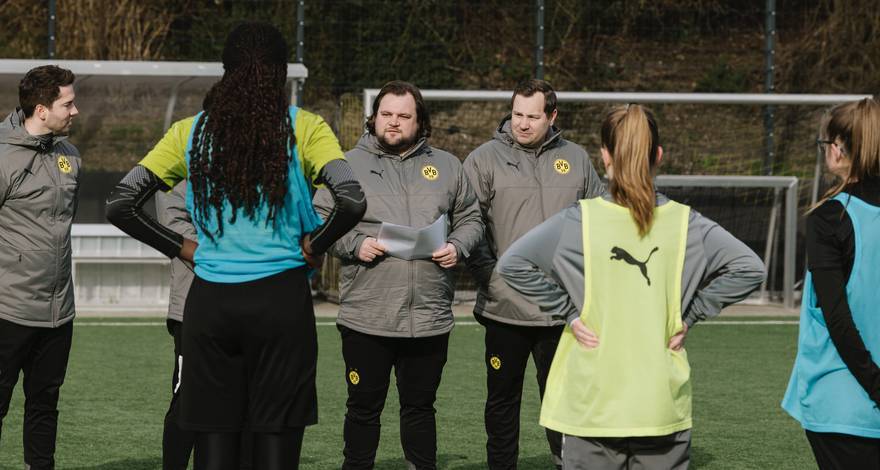Last weekend, our BVB women were able to secure promotion into the Landesliga. It is therefore all the more important that the fostering and training of talented youngsters is promoted at the club as well. The U17s will become the third team in the club’s fledgling women’s department this summer.
It was a cold Sunday afternoon in late-February. Some 35 girls between the ages of 12 and 16 are shaking ahead of the start of the training session used to recruit players for the team, and not only because of the cold – some of the players are visibly nervous. Split into two groups, they have just 90 minutes to demonstrate their skills and potential. They are vying to secure a place in the new Borussia Dortmund U17s team – the first girls’ team in the legendary Black and Yellow. The coaches help the girls shake off any initial shyness and are later impressed by what they have seen.
Like the first and second women’s football teams, the U17s will start in Kreisliga A. Once again, Borussia Dortmund are taking a very specific path, building up women’s football from the ground up, with a clear strategy. The idea is that ultimately, the teams will intertwine perfectly. If everything goes to plan, which may not necessarily be the case, but hopes are certainly high that the “first team” will be playing in the Bundesliga from the 2027/28 season, the “seconds” in the 2. Liga and the U17s in the Junior Bundesliga. “Then it makes real sense to have a strong second team, because the jump from the U17s directly into the first team could be extreme,” says Svenja Schlenker, head of the women’s football department. In contrast to the boys, there is no U19s level in girls’ football.
The idea is to give the players who are no longer young enough to qualify for the U17s a gentle transition so that they can “get used to the harsher environment with an eye to then potentially going on to play for the first team”, says Schlenker.
A girl who is twelve years of age today would actually outgrow the U17s in the summer of 2027 and would have to play in the adult game. There was actually a twelve-year-old girl at the recruitment training session, as well as a thirteen-year-old, “where we can already see so much potential,” said Schlenker, enthusiastically: “They are coming with so much talent.” And they are presenting the department with new challenges. “We have to look at each case individually, as everyone should be appropriately challenged. We have ambitious goals, but we will keep a close eye on the girls, and want to get the best out of them,” promises the 39-year-old. “We do not want to and will not put obstacles in the way of a girl’s career, and are also thinking about securing the ‘Zweitspielrecht’ rights for girls to play in two different leagues simultaneously. A 13 or 14-year-old girl who is already at a very high level will not continue to develop much in the Kreisliga.”
Evaluations regarding the best possible development of talented girls suggest that an education at the highest level with or against young male players close to their home offers the highest probability of a successful football career.
That is how the German Football Association (DFB) sees it Girls are allowed to participate in boys’ teams until the U17s, and in exceptional cases even until the U19 if they play for their national teams.
Svenja Schlenker has to think about the future and the present at the same time. Ex-international Annike Krahn and former BVB player Christian Timm, who have been providing advice on women’s football at Borussia Dortmund since the women’s department was established, have provided Schlenker and the now eight-strong coaching team with valuable expertise.
“To get a first impression, it was great,” says Schlenker about the recruitment training session. “Everyone was really nice, really open-minded – and everyone was able to play football at a very high level.” Now it is important to find a “good mix” for the first year in the Kreisliga A. The U17s will play and train at the Rabenloh site, where two additional dressing rooms have been built to house the now three women’s teams.

